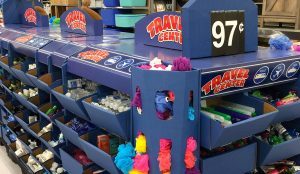The Supply Side: Retail-ready packaging on trend, required by Walmart
by May 21, 2018 2:30 pm 3,114 views

Retail-ready packaging or shelf-ready packaging is the standard at Walmart as the retail giant looks to simplify merchandising displays while also accelerating product sell-through without adding to the labor.
Walmart employees are told to touch the product only one time as it comes through the back of the store and is displayed on the shelf. Suppliers are asked to help by providing item packaging requiring no unpacking. At the retailer’s supplier summit earlier this year, Walmart said more focus was being placed on retail-ready packaging. Walmart said there were too many inconsistencies in package sizes and price points, which creates more work for store employees.
The retailer said suppliers must use standard heights and use single-item pricing and adhere to the two-pack rule, which requires that two cartons of product fit on the shelf in the allotted space, one-behind the other. Recently, Walmart U.S. CEO Greg Foran said too often store employees are having to touch products more than once, which drives up costs and reduces store efficiencies. Walmart defines retail-ready packaging as easy to identify, easy to open, easy to stock, easy to shop and disposable.
The industry estimates 25% of a retailer’s costs are related to labor, including finding products in stock, displaying product on shelves and disposing of leftover packaging. Retail-ready packaging goes straight to the floor and cardboard boxes are recycled when empty.
Companies like Atlanta-based WestRock works with Walmart and other retailers and suppliers on packaging solutions and displays. The global company has had an office in Bentonville for about 10 years, employing a dozen sales professionals who call on Walmart and suppliers. WestRock recently held an open house at its Bentonville location to discuss some of the latest trends in displays and item packaging.
Stephen Brown, vice president of marketing and innovation at WestRock, said packaging is part of the company’s reach into retail. As more displays are being created to enhance the shopping experience, Brown said there is a new opportunity for suppliers and retailers to think beyond the two-dimensional cardboard displays.
He said as Walmart and brick-and-mortar competitors dabble in “retailtainment” or finding entertainment while shopping retail, suppliers are starting to embrace more elaborate displays that can sit atop a pallet on the floor and require no shelf fixtures, which makes them easy to set up and take down.

WestRock is working with Kretschmar, a deli meat and cheese company, on a promotion with country singer Easton Corbin for a trip giveaway to the Country Music Association Awards later this year. The cardboard display with Corbin’s life-size image also has an audio feature that allows Corbin to tell consumers how they can enter to win. Brown said audio is easy to add to any retail display, and it allows for more personalization and localization.
Brown said large iconic displays around movie releases have also become more common in retail as a way for suppliers to merchandise licensed products in multiple categories in one central location. Walmart has done that with “Star Wars” and “Avengers: Infinity War.” In some Walmart stores, huge “Avengers” displays can be seen in action alley — the main aisle that runs in front of the electronics department. This large display has T-shirts, action figures, masks and other toys. WestRock has a similar large display relating to “Star Wars Battlefront II,” a video game.
Brown said the cost of large displays falls on the suppliers, but it’s a good way to ensure feature space as retailers are eager to see more flashy and easy to assemble displays that can be quickly changed when the promotion period has ended. He said retailers are also looking for ways to provide solutions to consumers who might have a long list of items relating to back-to-school or perhaps packing for a summer vacation.
Walmart is using large displays that centralize various products on consumers’ shopping lists. WestRock builds displays like the back-to-school train which sat directly on floor pallets and offered shoppers the chance to get most everything on their list from the same centralized display. At the recent supplier summit, Walmart called out the display as an example to follow in the future because it served the entire season without having to be restocked in most cases.
Brown said the design allows one full carton of items to sit behind the front row. When the first bin is empty the drawer pulls out and the second carton moves forward. There is no lugging more products from the back of the store or looking on the top shelf for products. The design serves multiple suppliers who are providing the one-stop solution.
This time of year with vacations on consumers’ minds Walmart has again gone to this design that holds items needed for summer travel. WestRock built a display with the same functionality of the back-to-school bus design. The large display is designed to last all summer and requires no additional stocking. The large summer travel display is situated near the luggage in the wide aisle running front to back of the store. The large display allows for $1.47 pricing on one side and 97 cents pricing on the other side.
Personal toiletries are usually found in the health and beauty aids section near the pharmacy on permanent shelf space that has to be restocked.
–––––––––––––––––––
Editor’s note: The Supply Side section of Talk Business & Politics focuses on the companies, organizations, issues and individuals engaged in providing products and services to retailers. The Supply Side is managed by Talk Business & Politics and sponsored by Propak Logistics.
